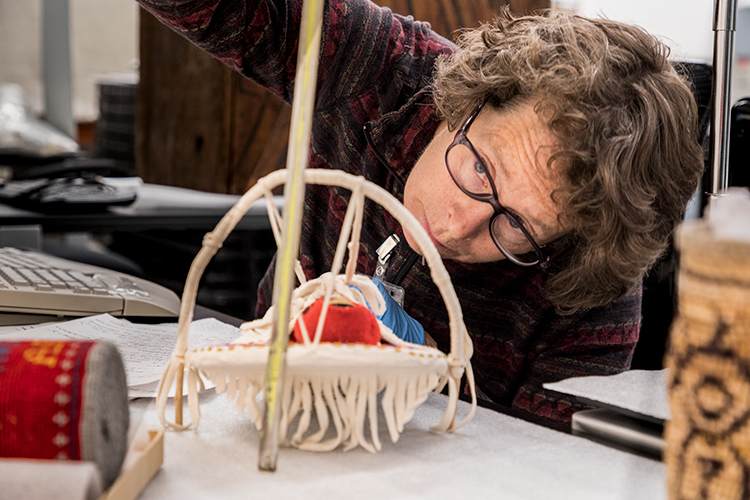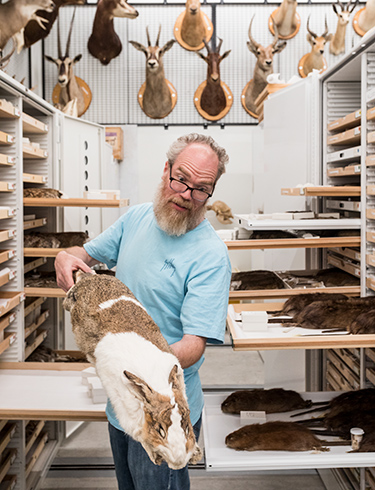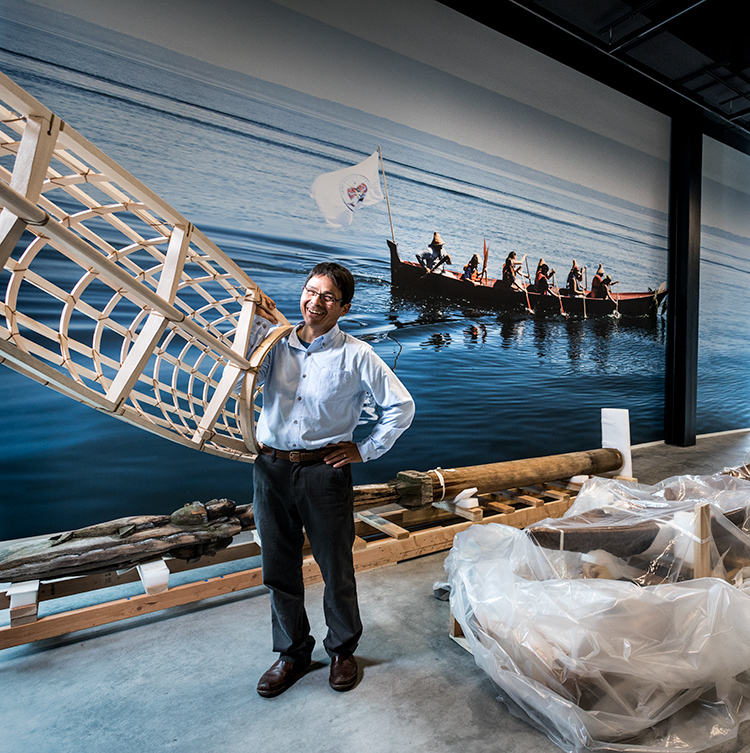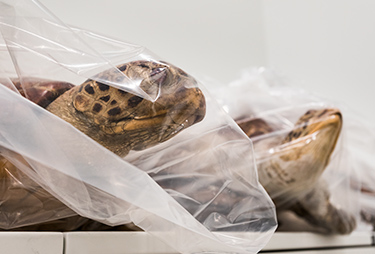The Burke, unwrapped The Burke, unwrapped The Burke, unwrapped
Washington’s oldest museum gets a new home and a bold new approach — an open design that puts both artifacts and researchers on display.
By Hannelore Sudermann | Photos by Brian Smale | September 2019

On the second floor in a sunny southwest corner of the new Burke Museum, the disarticulated wings of several Sand Hill Cranes fill the drawers of a drying rack. The rack sits on one side of a processing laboratory where animal specimens—from tiny mice to a full-grown jaguar—are prepared and preserved for future study. The ample space features a sink, long prep tables, a refrigerator and, on an inside wall, a massive picture window that makes every corner of the room visible from the visitors’ gallery just outside.
Down the hallway, bones and fossils fill the shelves behind more big windows. Past the bones is a view of collection manager Jeff Bradley clambering atop a bank of white storage cabinets to arrange and store sets of antlers. Furry mounted heads of moose, deer, goats and other cervidae and bovidae look on from the walls.
One floor up, paleontologists and volunteers behind three big windows clean the massive 60 million-year-old head of the Tufts-Love T-rex and piece together a 20,000-year-old mammoth tusk discovered in a 2014 excavation at South Lake Union. One floor down, yet another set of windows open the view into the accessions room where first-year museology student Sarah Dickinson patiently builds a paper mount for a hand-woven hat. A newly arrived, but very old, bentwood cedar box from the Bella Bella tribe awaits the attention of the ethnology collection’s manager. But first Rebecca Andrews is busy making notes on another artifact. “No two days here are the same,” Andrews says as she types a description into her computer, new items all around. “Yesterday, we went to a potential donor’s house, and I came back to find eight new objects waiting.”
In most natural history museums, this work of collection, curation, preservation and study takes place in the back rooms, far from public view. And for most of its 120-year history, that has been the case at the Burke Museum. But now, in an exciting new building designed by renowned architect Tom Kundig, it all comes out into the open.
And that has everyone a little bit nervous.
***

Rebecca Andrews, manager of the North and South American cultures collections, catalogs new acquisitions.
Since 1964, the Burke Museum has lived in the northwest corner of campus. It is an active research museum. And as the state’s oldest public museum, it serves as a place for preservation and exhibition of historical documents and objects. It’s also home for collections of flora, fauna, rocks and fossils. Scientists and scholars from around the world rely on the Burke’s collections to broaden their understanding of critical issues facing humanity—the global climate crisis, evolution, biodiversity, cultural awareness and protecting ecosystems. So why hide it?
That’s why the new state museum, scheduled to open in October, sits proudly on the corner where 15th Avenue Northeast meets Northeast 45th Street—perhaps the busiest corner of the U District. Home to more than 16 million objects, the Burke houses relics of our Pacific Northwest cultural history and serves as a collections center for animal DNA. And it maintains important specimens to help scientists answer key questions and recognize how populations change over time, study the impacts of pesticide use, and identify and help threatened species.
The galleries, with their displays and descriptions, are only the first step in delivering those lessons, says Julie Stein, an anthropologist who has served as the Burke’s director since 2005. Seeing a scientist collect tissue from a bat, watching a graduate student prepare a basket for storage, or witnessing a dinosaur fossil emerge from its earthen shroud, you gain a deeper understanding than any lesson found in a textbook or online.
“I have heard repeated over and over: I had no idea that this was going on behind the walls of the galleries,” Stein says of her tours through the laboratories and collections. “That really was the inspiration behind our inside-out concept. Can we give every visitor the experience that only the students and special visitors used to get?”
***
In 1879, when Washington was still a territory and Seattle a fledgling city of about 3,500 people, a group of teenagers formed around a common cause: natural history. Charles L. Denny, the son of Seattle founders Arthur and Mary Ann Denny, hosted the club meetings at his family home. Edmond S. Meany, who would become a UW graduate, journalist and later a professor of botany and history, served as the first secretary.
Calling themselves the Young Naturalists, they combed area beaches, fields and woods collecting insects, shells, rocks, plants and mammals, preserving and storing them at the Denny family house. Inexpert as they were, they managed to develop and maintain a substantial cabinet of wonderful things.
Their work turned scientific and the membership grew with the 1882 arrival of Orson “Bug” Bennett Johnson, a professor of natural science at the Territorial University of Washington. In 1885 the group had outgrown its meeting space in the Denny house and in just a month raised $1,400 for a building all their own. They quickly built the Hall of the Young Naturalists right next door to the Territorial University building.

Jeff Bradley, who manages the mammology collection, holds a large domestic rabbit that once lived at the Woodland Park Zoo.
This busy group organized summer expeditions to retrieve specimens from around Puget Sound, offered lecture programs in the cooler months and, by 1894, expanded their membership to include women, many of whom were teachers. These teachers, according to a history of the society by professor Keith R. Benson, linked the Young Naturalists with secondary schools, enhancing local science education for the city’s children. But for all the good it did, the society’s days were numbered—because of the UW’s emergence.
In 1895, the University moved 4 1/2 miles north to the Montlake neighborhood, taking with it the faculty experts and parts of the collection vital to the Young Naturalists and their hall. Then the Legislature passed a bill to establish a state museum on the University’s new campus. In 1905, the society members decided to simply end their organization, but their legacy continues through the University’s natural history and zoology programs and through the Burke Museum. Over 50,000 objects—specimens, Native American artifacts and art—from the society became the property of the state museum and were moved to the new UW campus.
And the collections grew. Several major American expositions around the turn of the century brought in cultural objects and artworks collected from Salish tribes and the Columbia River Basin. And finally, in the wake of the 1909 Alaska-Yukon-Pacific Exposition, more than 1,900 Northwest coast artifacts—primarily from Alaska—and 20,000 artifacts from the Columbia Basin were added.
For a number of years after AYP Expo, the colorful structures that it left behind on the new UW campus served as homes for the museum. Most notable was the fair’s forestry building. Crafted with massive, unstripped logs of Douglas fir and filled with leftover exhibit cases and displays, it was an intriguing venue. But by the 1930s it had succumbed to dry rot and bark beetles and was demolished. The collections then were scattered around campus. The museum moved to a third AYP structure—the Washington State Building. That building, because of its construction flaws, had to be closed in 1957.
For a few years, the museum had no home at all.
In 1964, with financial support from the family of Judge Thomas Burke, a new museum opened on the northwest corner of campus. The brutalist-style building was a quirky character. It held a handful of galleries and meeting rooms in about 70,000 square feet of space. Even at the start, it was a tight fit for the collections and work it needed to house. Students scraped bear guts in the parking lot, and a curatorial team bleached a fresh whale skeleton on the roof. And the research teams were packed into little rooms. The DNA lab conducted work in the hallway, and some of the collections had to be housed off site. Finally, what was stored there was vulnerable to an ancient and inefficient climate control system.
The time had come for the museum to improve and expand.
***

Conservator Corine Landreau, front, and an assistant repair a 300-year-old boiserie panel that used to hang in the old Burke Cafe. The panels are now displayed in a public area adjacent to the museum lobby.
Architect Tom Kundig remembers the museum from his time as a student. “It was in a prominent spot, but it wasn’t,” he says, of the 1964 building. “It was in a weird spot, buried in a bunch of weedy plants with parking lots around it.”
As an undergraduate with an interest in science, he visited a few times. When he was tapped to work on the new museum, he already knew the challenges. “I came in saying, the big problem of museums is that it’s really hard to get people across the threshold,” he says. Visitors were describing the old Burke as dark and disorienting. “How do you make a museum welcoming and porous?”

Architect Tom Kundig, ’77, ’81, tapped into his love of science, art and simplicity in designing the new Burke.
Kundig also knew the building needed to connect to the city street to be more welcoming to the public. The new structure, a 110,000-square-foot modernist-style museum clad in eco-friendly wood, faces the neighborhood. Instead of a mysterious structure in the trees, it is a massive cabinet of wonders.
Architectural Digest describes the work of his firm, Olson Kundig, as a “rugged-meets-refined aesthetic with a laid-back Pacific Northwest spirit.” That’s exactly what museum leaders were looking for. A few of Kundig’s hallmarks—the elegant use of simple materials like concrete and steel, the fine details, and the “gizmo,” a human-powered pivoting window wall—are there, but they don’t really call attention to themselves. “The architecture is supposed to be kind of silent in a way,” Kundig says.
As would any eager museum visitor, Kundig took the time to visit and learn from faculty and staff. One of the curators described the Burke as a library for visitors interested in natural resources. They come in, find the source, pull the data and then study it. It’s a DNA repository—one of the largest in the world for bird DNA, a collection museum—and home to more than 50,000 artifacts from indigenous communities around the world. And among it all, a river of schoolchildren and visitors pours through each day. “It’s moving all the time,” Kundig says. “It’s a building about big bones and small shells. All of the ‘ologies’ are in there,” he says. “Ultimately life is about understanding. People come here because they’re trying to figure out what the real story is.”
What the Burke does—bringing forward both science and art—made the project especially poignant for the architect, whose projects range from big public spaces like the new Tillamook Creamery to low-impact rolling huts in the Methow Valley. “This is actually a really sweet spot for me. It intersects the rational and the poetic,” he says. “You can see what Native Americans thought about a raven, and then you can go to ornithology and look up a raven,” he says. “It’s almost a physical manifestation of a Google search.”
***

Anthropologist Sven Haakanson holds a frame he made with expert traditional kayak builder Alfred Naumoff for the new Culture is Living gallery.
Natural resource managers use the herbarium collections to make land stewardship recommendations, the commercial fishing industry looks to the Burke for data to develop quotas for fishing. The paleontology team makes casts of its fossils and sends them out to other museums for display and study. Tribal land resource managers, artists both Indigenous and not, and natural history illustrators all use the collection. So do students, researchers from around the world, and notebook sketch artists.
A zoo recently borrowed a gorilla skull for a surgeon to use as a skeletal reference for a surgery on a live animal. Gertie the hippo, once the oldest resident at the Woodland Park Zoo, died in 2010 at age 47. Her bones, now at the Burke, are helping zookeepers understand osteoarthritis in other zoo mammals.
But now, more than ever, the museum will be a place where campus meets community, where members of the public can visit real, active laboratories. “The front doors face the University District and 35-foot-high windows say to the visitor, ‘This is a museum for you. ‘Come in!’” says director Stein. Her office has its own big window providing visitors to the third floor a view of her working at her desk.
Upon entry, they will pass under the massive bones of a beaked whale, and then up to the first floor, where boats from indigenous communities in Asia and the Northwest float from the ceiling and sail across the concrete in one of the most stunning new gallery spaces. “This is very much a space where people from indigenous cultures can take the lead in what visitors may see,” says Sven Haakanson, anthropologist and member of the Sugpiat community in Southern Alaska. “They will share the stories they want to share, not what we think they want shared.”
Signs will first be in the language of the community to whom the cultural items belong, and their content will be about what each piece on display means to the community now. “These things are the past and the present,” Haakanson says.
The Federal Native American Graves Protection and Repatriation Act, enacted in 1990, prompted the museum to deepen its ties with Native American communities, furthering the assistance to tribes in their cultural heritage efforts and inviting Native people in to contribute to the research and explorations of their culture taking place at the Burke. Too many museums treat native ethnographic collections as items of the past, says Polly Olsen, ’94, the museum’s tribal liaison. But the tribal members know these are living cultures. The museum has opened its doors and drawers to tribal members, artists and researchers. “These collections are made for everybody, especially the descendant communities,” Stein says. “They are the most important group to bring to the museum.”
Most museums are experienced through galleries and cases. And even as recently as 20 years ago, natural history and cultural museums were guarded by the curators and collections folk. “They got to say who could see the objects and who couldn’t,” Stein says. “That was less true for the Burke museum because of our curators. They brought people in.”
Now they are going further. Where in the old museum, only 30 percent was visible to the public, in the new Burke it’s more than 60 percent. “Everybody should be able to come in here and see the research and see these objects,” Stein says. The Burke now realizes that the galleries are just the first of many steps in engaging and informing visitors, she adds. “The concept of ‘inside out’ is going to give the visitor a path to follow to incredible knowledge and a path to our experts for learning about things like climate change and culture.”

Sea turtle specimens are sheltered in plastic while they wait for their permanent place in the new museum.
The students and staff practiced this concept in one of the galleries of the old museum. They moved into workspaces and set up printed signs describing their projects, but the visitors much more appreciated the small handwritten white boards. They loved the content like “Oh, what big teeth you have” on one of the dinosaur projects. They even loved watching curators painstakingly examine an object and enter data into a computer. They lingered longer in the work areas than the exhibit galleries, Stein says. “Kids had to be dragged away from the animal preservation work.”
Tech takes a back seat in this museum. Instead of theaters and computer screens, visitors get to see real things. But that also means the curators and collection managers have to think about the experience on the other side of the windows. What objects could be moved, what projects could change from day to day? What will engage, excite and possibly—say in the case of dissecting a 15-foot anaconda—offend?
“We’re all a little bit nervous,” Stein says. “We’re not the first museum to have opened up views into the work we do. But we are the first to have done it to this extent.”